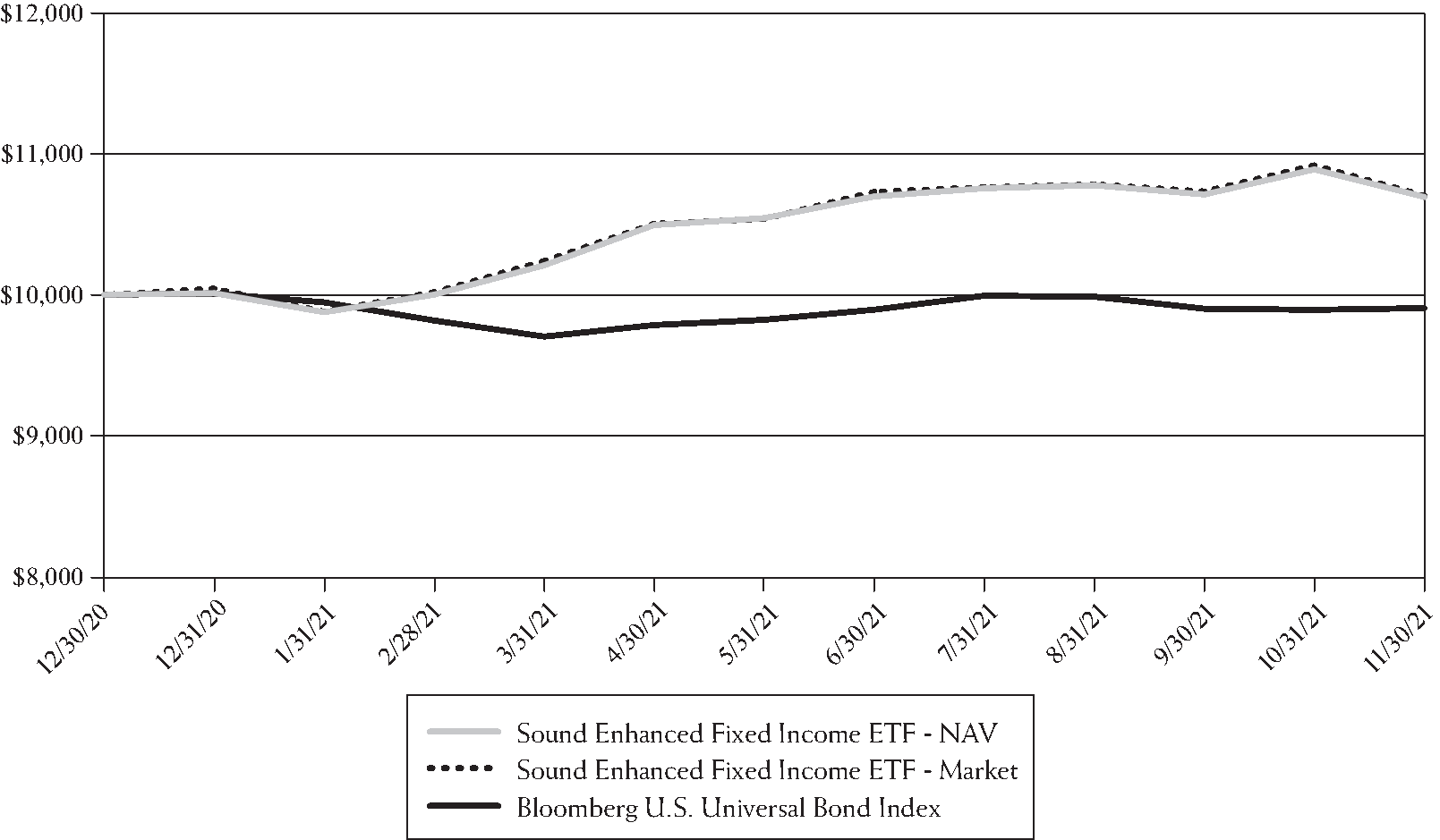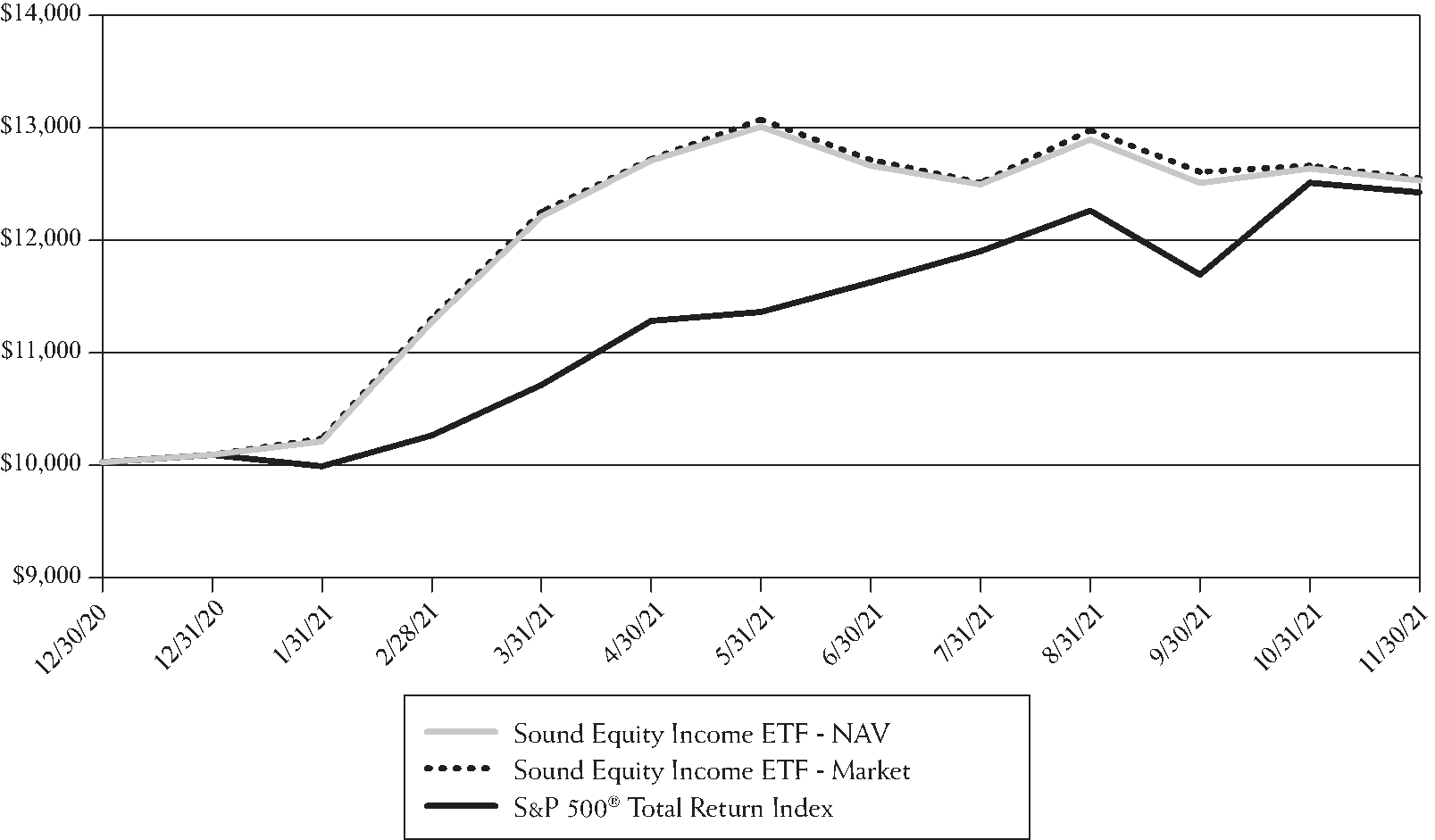The Sound Equity Income ETF (“SDEI” or the “Fund”)
Dear Shareholders,
Thank you for choosing to invest in the Sound Equity Income ETF in its inaugural year.
As required by the SEC, we would like to take a moment to recapitulate the Fund’s strategy. Then, we will discuss the stocks and fundamental elements that led to our relatively strong performance this year versus the S&P 500 Total Return Index (“S&P 500”) and the Russell 1000 Value Index (“Russell 1000 Value”).
While we do not regard either index as a representative benchmark for the Fund, on account of the structural differences between SDEI and these much larger indices, we do think they provide useful bases for comparison, in terms of relative yields, returns, and sector performances, as the indices and the Fund focus on large-capitalization, U.S.-listed stocks. Also, the Russell 1000 Value reflects a similar value-oriented investment discipline, albeit without the high yield emphasis, which provides some contrast, as does the S&P 500 with its much heavier tech concentration and growth bias. By looking at the behaviors of the Fund and the two indices, we can get a sense if the investment regime (value versus growth), strategy (high dividend/ short duration) or stock selection led to our relatively good or bad performance.
As described in our mid-year letter, SDEI is a large-cap, value-oriented, U.S.-listed, common stock portfolio, whose key characteristics are that every stock must pay a dividend and the targeted portfolio yield, on a gross basis, must be at least 2.0X that of the S&P 500. The Fund’s portfolio is concentrated, holding 30 to 35 names, with a maximum weight of 6% in any one company. Unlike many other high yielding equity funds, SDEI does not invest in master limited partnerships (“MLPs”), real estate investment trusts (“REITs”), tobacco companies, preferred stocks, or ETFs. It owns common stocks that pay qualified dividends, which are currently taxed at a lower rate than dividends or interest paid by MLPs, REITs, preferred stocks or bonds.
Because high yielding stocks tend to be more mature, with less sales and earnings growth than the average stock in the market, they tend to trade at lower valuation multiples and appreciate less than the market cap weighted S&P 500 does. We seek to offset some or all of this performance drag by selecting companies that typically have a catalyst that could lead to above average income growth or stock price appreciation, such as a recovery from a temporary problem, a new product or management team, a recapitalization, or tightness in its end markets. Because such companies are hard to find, SDEI has a fairly concentrated portfolio. Also, because it generally takes a lot of time for companies to execute on their catalyst / transformations, the Fund should have a much lower turnover than most other funds.
In 2021, we positioned SDEI to benefit from the re-opening of the U.S. and global economies, following the Covid-19 pandemic policy shutdowns that were imposed worldwide. The goal was to find high-yielding stocks that would benefit in a “return-to-normal” economic situation. Accordingly, we over-weighted the Fund’s holdings into the financial, energy and materials sectors, relative to the market, and balanced this tilting with some less-cyclical holdings in healthcare and utilities, including Pfizer, which has been a significant beneficiary of the pandemic, due to its effective and highly desirable vaccine and antiviral programs. We would like to have invested in more consumer cyclical firms, as consumers have built up significant excess savings and pent-up demand in the pandemic, but there simply has not been as many suitable, high-yielding stocks in that sector, as we would have liked.
It is important to note that a portfolio of high yielding stocks has a shorter mathematical duration than a portfolio of average or long duration growth stocks, where most of the value is based on an estimated discounted present value of cash flows projected to come in the future, versus actual current cash flows being paid to investors today, in the form of dividends. Because of this mathematical trait, in periods of rising interest rates, dividend paying value stocks tend to outperform growth stocks and in periods of falling interest rates, long duration growth stocks tend to out-perform their value counterparts.
With strong inflation throughout the year, we were expecting to benefit greatly from rising interest rates, which was the case through the end of May 2021. However, with the resurgence of Covid-19, in the form of the Delta variant, mid-2021, interest rates started falling, and the reopening trade began to stall. This covid stall ebbed and then re-emerged again in November 2021, as the Omicron variant emerged. These shifts, more than any other factor, trimmed our relative and absolute performance, as it sent growth stocks higher, and value stocks lower, or at least flat for most of the remaining year.
Putting these elements altogether, in the period from December 30, 2020 through November 30, 2021, the Fund returned 25.05%, 1.06% above the 23.99% total return of the S&P 500, and 6.71% ahead of the Russell 1000 Value. In our mid-year report, we were 12 to 15% above these two large-cap indices, respectively, but since then, the return of covid-19 and falling interest rates have unwound much of the return to normal, short duration advantages that we enjoyed in the first half of the year. Fortunately, the November 30th mark seems to be a low ebb for the Fund’s relative performance, as in December 2021, we have widened our lead over the benchmarks again. As reported in the Wall Street Journal, with over 85% of active managers trailing the S&P 500 in December 2021, even our small lead paints us in a good light, especially amongst value managers, who are nearly all lagging the S&P 500.



